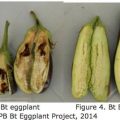The Food and Drug Administration (FDA) will not require labeling of genetically modified (GM) food as it virtually has no difference from conventional food, is not cancer-causing, and has been proven safe for human health under numerous tests.
Packaged products containing GM crops like the Bacillus thuringiensis (Bt) corn and those that are not yet in the market—Bt eggplant and the pro-Vitamin A-rich Golden Rice– have no verifiable difference at all from any other conventional crops.
These are as safe as the usual crops in the market. The nutrition contents too are substantially equivalent compared to usual farmers’ produce.
“Labeling is only mandatory if there are safety issues. There are no safety issues, so why should GM food be labeled?” said Dr. Oscar Gutierrez Jr. of the Philippines’ Food and Drug Administration (FDA) “It’s not the technology that’s important in labeling, but the finished product. Is it safe? Is it of good quality?”
The difference between GM and non GM crops is the presence of recombinant DNA or the protein gene that is present in GM crops. However, in the process of cooking the GM crop, the protein is destroyed or denatured.
“Once cooked, it’s no longer there. The food no longer carries the verifiable recombinant DNA. So what is there to label?” Gutierrez said.
In processed products like corn oil or corn syrup which are by-products of both GM and non-GM crops, nutritional content is practically the same in all aspects.
Draft guidelines
In “Draft Guidelines On Labeling of Prepackaged Foods Derived from or Containing Ingredients from Modern Biotechnology, ” FDA specifically indicated that it will not require labeling for GM packaged foods.
“Special labeling shall not be required for prepackaged food products derived from modern biotechnology that are highly processed as to eliminate the verifiable presence of recombinant DNA (rDNA) or its resulting protein.(These) are substantially equivalent compared with its conventional counterpart or as safe.”
This regulation is harmonized with globally-recognized food safety standards Codex Alimentarius listed in the “Compilation of Codex Texts Relevant to Labelling of Foods Derived from Modern Biotechnology.”
The Guidelines indicated that special labels will only be required when there is safety concern about food.
This is when there is “significant change in composition, level of toxin, toxicity, allergenicity, nutritional value, or intended use of the food product as compared to its comparator.
More rigorous
In its Advisory No. (AN) 2013-014 on “Safety of GM Food Produced Through Modern Biotechnology” dated June 24, 2013, FDA stated that food safety assessment of biotechnology products “is more rigorous.” That is compared to other conventional bred crops.
“For the GM food crops that have undergone food safety assessment and approval process, the consensus of scientific opinion and evidence is that the application of GM technology introduces no unique food safety concerns and up to this time there is no single case of evidence of harm in man,” declared FDA.
International organizations that support this evidence also include the National Research Council of the U.S; National Academy of Sciences of Australia, Canada, India, Mexico, UK, USA, and Philippines; Society of Toxicology, Royal Society of Medicine, England, American Society on Science and Health, American Council on Science and Health, American Dietetic Association, American Society for Microbiology, Federation of Animal Science Societies, and American Medical Association.
EO 430
In the Philippines, laws that regulate GM crops include Executive Order (EO) 430 which regulates contained field tests (laboratory, greenhouse, screenhouse). Moreover, the agriculture/” title=”View all articles about Department of Agriculture here”>Department of Agriculture Administrative Order No. 8 of 2002 regulates GM crops’ field release and commercialization for direct use as food, feed, and for processing.
The National Biosafety Framework also determines safety of GM products.
“It takes around 10 to 14 years of laboratory research, contained greenhouse, contained small scale field trials, and pre-commercial testing and evaluation before a GM crop is approved for commercial release,” according to FDA.
Nutrient analysis
Evaluation includes those for nutrient analysis, proximate composition such as ash, moisture, protein, fat and carbohydrates, amino acid analysis, fatty acid analysis, carbohydrate analysis, vitamins and mineral analysis, level of anti-nutrients, level of naturally occurring toxins and level of naturally occurring allergens to determine the safety of GM crops compared with the conventional crops.
Comparisons between GM and non-GM crops also include agronomic performance, phenotype, expression of transgenes, and assessments of any proteins that are produced from the inserted DNA.
“Since food allergens are proteins, the potential allergenicity of newly expressed proteins in food are also considered. A decision-tree approach introduced by International Life Sciences Institute and International Food Biotechnology Council has become internationally acknowledged and was updated by Codex,” said FDA.
Farmers’ choice
FDA noted that with GM crops, Filipino farmers have a choice.
“Farmers who do not want to plant biotech crops may use conventional seeds that are widely available.”
Farmers planting corn have chosen to plant the GM Bt corn which as of 2012 occupied 719,446 hectares. This area was up from 685,372 hectares in 2011 and was a steady increase from around 10,000 hectares when it was first planted in 2003, FDA noted.
“Farm level economic gain from GM corn in the Philippines from 2003 to 2011 was estimated at $264.5 million. In 2010 alone, when there was corn shortage, the Philippines’ farm level economic gain was at $93.6 million. The number of small farmers, growing on average two hectares of GM corn, was estimated at 375,000 in 2012, up significantly by 53,000 from 322,000 in 2011.”
GM in the Philippines
There are at least 34 transformation events (gene insertion process) involving GM food that have been approved for commercial release in the Philippines.
These are those for corn, soybean, canola, potato, cotton, sugarbeet, and alfalfa. These are for various uses as food, feed, and processing.
For local propagation, approved GM transformation events include those for Asiatic corn borer-resistant Bt corn and those GM corn with stacked or combined trait including herbicide resistance.
The Department of Agriculture-Bureau of Plant Industry’s risk assessment of GM crops includes those for analysis of species or taxonomic group, nomenclature, geographical distribution under different ecosystems and habitats, and centers of origin and diversity,
About Codex Alimentarius
The Codex Alimentarius Commission (CAC) was established by the Food and Agriculture Organization and World Health Organization in 1963 to develop harmonized international food standards, guidelines and codes of practice to protect the health of consumers and ensure fair trade practices. The Commission also promotes coordination of all food standards work undertaken by international governmental and non-governmental organizations like European Food Safety Authority and International Life Science Inc. The Sanitary Phytosanitary Agreement of the World Trade Organization ensures that that internationally traded food meets the standards based on the scientific principles set by the CAC.
###
Bt eggplant
The development of the GM Bt eggplant in the Philippines is currently being conducted by the University of the Philippines Los Banos’s Institute of Plant Breeding (IPB). It is sanctioned by the Seed Industry Development Act (SIDA) of 1992 which created IPB so that a local seed industry may flourish.
Some high yielding seeds in the country are still imported including some hybrid vegetables and hybrid rice or corn.
While the Court of Appeals affirmed its writ of kalikasan that effectively stopped seed propagation of Bt eggplant, IPB asserted it follows strict regulatory standards of its field tests.
“We have put in place for the last 12 years a protocol. We have had so many field testing with no proof or evidence that that it has harmed the environment or the Filipino people,” Dr. Desiree M. Hautea, Bt eggplant project leader.
“It’s a standard practice observed by all countries and agreed upon under the Cartagena Protocol on Biosafety. In a writ of kalikasan, there should be an imminent threat, and it should be catastrophic. But here we’re testing on less than 1,000 square meters. How can that be catastrophic? When we computed the percentage of our field trial over total Philippines, it is very miniscule. How can that be imminent?” said Hautea.
The gene that is in Bt eggplant is also in Bt corn that is now widely planted in the country.
Traditional eggplant planting is more harmful.
“You can’t grow eggplant without using pesticides,” said Hautea. Surveys show Pangasinan farmers even dip eggplants under a bucketful of pesticide to ensure these are free from the pest fruit and shoot borer (FSB).
“Some farmers use broad spectrum (pesticides) which kill even beneficial insects. Bt is an organic matter. Others really spray Bt as an organic pesticide. But here, only the gene that produces the protein that kills pests (FSB) is in the Bt eggplant,” she said.
Bt eggplant trials are funded by UPLB, Department of Agriculture, and some fund from the United States Agency for International Development.
###
Please see attached PDF– FDA Safety of GM Food; FDA AN 2013-014:
http://www.fda.gov.ph/attachments/article/80234/DRAFT-Guidelines%20of%20prepacked%20foods%20derived%20from%20or%20containing%20ingredients%20deriv
For any questions, kindly contact Dr. Oscar Gutierrez (FDA), 857-1900; for interview requests, Ms. Analiza C. Mendoza, 0921-338-3816, 0916-266-6604.






